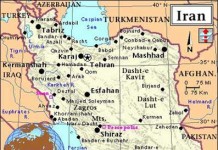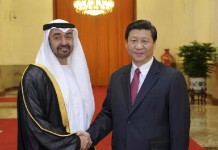 According to recent media reports, prominent Pakistani Taliban commanders have held meetings with Al-Qaeda leaders and Afghan Taliban. The first one was held on November 27 in Wanna, South Waziristan, while the second one took place on December 11 in Datta Khel, North Waziristan. During these meetings, Al-Qaeda and Afghan Taliban leaders tried to convince Pakistani Taliban to set aside their differences, and assist them in their fight against the US-led coalition forces in Afghanistan.
According to recent media reports, prominent Pakistani Taliban commanders have held meetings with Al-Qaeda leaders and Afghan Taliban. The first one was held on November 27 in Wanna, South Waziristan, while the second one took place on December 11 in Datta Khel, North Waziristan. During these meetings, Al-Qaeda and Afghan Taliban leaders tried to convince Pakistani Taliban to set aside their differences, and assist them in their fight against the US-led coalition forces in Afghanistan.
In a fashion similar to the meetings in FATA, Pakistan’s jihadists also came together in a recent get-together in Lahore. In this gathering, banned religious group Jamaat-ud-Dawa (JD) protested against the granting of Most Favored Nation (MFN) to India, and declared it was ready for jihad against NATO. The gathering of 44 right-wing entities and personalities was held under the banner of the Difaa-i-Pakistan Council (Pakistan Defense Council).
The meetings in FATA have taken place as US drone strikes were on hold in the aftermath of the November 26th NATO Mohmand strike. Furthermore, for the first time, Afghan Taliban have formally accepted it is involved in negotiations with the US, and have consented to the office in Qatar for this purpose. With this background, two main interpretations have emerged on these meetings and the motivations behind them. One of them suggests the emergence of new extremist alliances represented by Islamic hardliners, while the other presents growing fissures within these groups.
Analysis
Reports indicate senior Al-Qaeda leader Abu Yahya al-Libi, as well as Sirajuddin Haqqani of Haqqani network, attended the gatherings in FATA. Other leaders attending included Hakimullah Mehsud and his deputy Waliur Rehman of Tehreek-e-Taliban Pakistan (TTP). Spokesperson for TTP, Ehsanullah Ehsan stated that Maulvi Nazir and Hafiz Gul Bahadur, which Pakistan considers as Good Taliban, including Afghan Taliban Zabiullah Mujahid and Maulvi Sangeen, were also present. Some accounts suggest that Mullah Omar had sent Siraj Haqqani and Mullah Mansour to broker the agreement.
The following outcomes have resulted from the FATA meetings:
• Formulation of a consultative body known as Shura-e-Murakeba that will sort out differences between the groups
• Avoiding the unnecessary killings and kidnappings for ransom
• Ending of attacks on Pakistani military while refocusing efforts towards US led coalition in Afghanistan.
The declaration of not attacking Pakistani forces could be the result of peace negotiations, taking place between the TTP and the country. However, according to media reports, TTP has not fully committed to ceasing its attack on Pakistani targets. On the other hand, despite the rift with US, Pakistan’s military operations have continued against TTP in FATA.
In these circumstances, the declaration has proved to be short-lived. TTP claimed responsibility for killing 15 Frontier Constabulary personnel on Thursday that were abducted on December 22 from Mullazai Fort in Tank. TTP has stated it was retaliation for the January 1st operation in Khyber Agency. In this particular offensive, Pakistani Taliban commander Qari Kamran was also killed. Qari Kamran was involved in the suicide attack on Shabqadar that killed 90 cadets, and the twin bombing in Nowshehra that resulted in the death of 20 people.
On January 6th, TTP announced the release of remaining 16 children that were abducted from around Bajaur Agency last September. These events suggest that TTP is not sticking to the spirit of the talks with Al-Qaeda and Afghan Taliban. Moreover, there may be divisions with in TTP on how to proceed in the future. A few media sources have reported that a rift has emerged between TTP leader Hakimullah Mehsud and his deputy Waliur Rehman and that it could soon develop in to a full blown infighting. Hakimullah Mehsud is accused of accepting support from India. Among others, Hakimullah has also been at odds with Mullah Nazir of South Waziristan, Hafiz Gul Bahadur of North Waziristan, and Fazal Saeed of Kurram Agency.
This kind of infighting would obviously be detrimental for the cause of the Afghan Taliban, as they would like to present a united front in the reconciliation process. However, this is a daunting task as the interests of TTP are more geared towards Pakistan while Al-Qaeda has a more regional and global agenda. The events of this week also negate the perception that these gatherings in FATA are the Pakistan army’s attempt to pull the extremists together. It is Pakistan’s pressure on TTP and the groups’ insistence to continue attacking the military, which is preventing a firmer alliance to develop between the various Taliban factions. This in turn helps the US strategy to divide these groups and develop an upper hand in the peace talks.

Nonetheless, the Mohmand attack is proving to be a turning point towards changing the nation’s threat perception. Pakistan may be extending the Good versus Bad Taliban differentiation to Good versus Bad Islamists, and this also helps in putting the Lahore gathering in perspective.
After 9/11, Pakistan had to shift its focus to FATA and to challenge Al-Qaeda and many other formulations of extremists that came to reside there. Overtime, the US and NATO pressured Pakistan to revise its traditional national security premise away from India and towards dealing with extremists. The Mumbai incident served as a proof that the danger Pakistan faced was not external, but internal. This argument was used to convince the country in moving its troops from its eastern border, to carry out operations in FATA, including North Waziristan. Now, the pendulum may be swinging back to its original formulation.
The ground situation has been altered to such an extent because of the war against terror and the so-called Islamic Spring that it is no longer possible for the liberal and secular quarters to deliver. It may be because of this stark reality that the emerging US policy in the Middle East and South and Central Asia is no longer premised on preventing the Islamists from gaining power, but to counter and temper the extremists by using the moderate Islamists.



